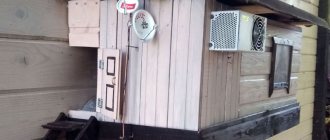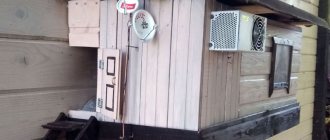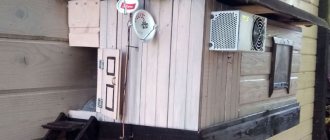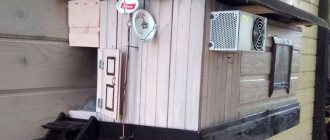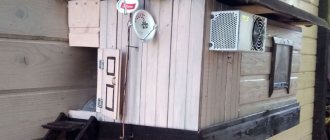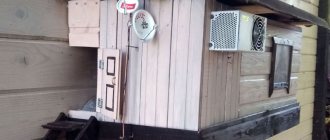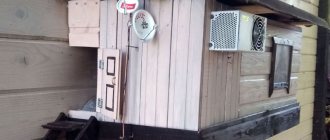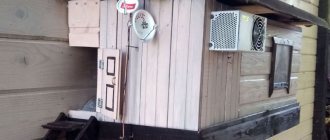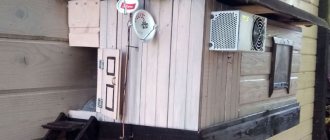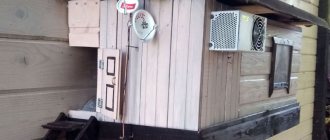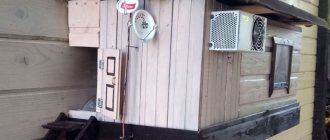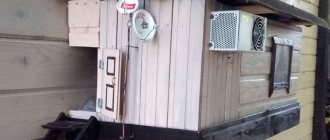Another homemade product for those who are bored at home
I needed a couple of antennas for digital, in places with “not the best reception”... I went shopping (this was before self-isolation - if it’s relatively budget-friendly, then it’s complete G. The more expensive one looks decent, but how it works is questionable.
- if it’s relatively budget-friendly, then it’s complete G. The more expensive one looks decent, but how it works is questionable.
I decided to make something homemade. It was somehow awkward to “twist” an antenna from a piece of cable (although rumor has it it works) - I wanted something simple, but more decent and advanced
In fact, the one I made is not radically more complicated, but somehow more “solid” or something. And the results of its testing were very encouraging, so I decided to sketch out a short description of what and how, in case someone else finds it useful 
... even if my street cats have a “normal” antenna on their house, what can you do without an antenna?!
The wire is not all finished yet, now we’ll assemble something!
In the places described, I previously used home-made broadband log-periodic antennas, probably since the “beginning of perestroika.” They worked well in analog and not only on UHF, but “for some reason, digital was too tough for them.” I didn’t really delve into the essence of the reasons, I removed them and began to think about what to replace them with. Here is one of them, waiting for a place in the trash
They worked well in analog and not only on UHF, but “for some reason, digital was too tough for them.” I didn’t really delve into the essence of the reasons, I removed them and began to think about what to replace them with. Here is one of them, waiting for a place in the trash
A little history
In the early 60s of the last century, our compatriot Kharchenko K.P. developed a simple flat zigzag antenna with good characteristics.
Copyright certificate No. 138277 for an invention called “Band directional antenna” was issued to Konstantin Pavlovich Kharchenko in 1961 (according to his application dated June 16, 1960). In the same year, materials were published in the magazine “Radio” for repetition by radio amateurs.
The antenna is not critical to materials and dimensions during manufacturing, has a simple good match with the reduction cable, and it successfully combines multiple elements of a common-mode antenna array with a single feed point.
Types of decimeter antennas
The UHF range may be the only one recommended or one of the possible ones for an antenna array.
UHF receiving antennas are classified according to the presence of an amplifier:
- Active - grilles with a built-in amplifying device. They are suitable for reception over 30 km. Active models require power supply; it is supplied from the mains or via a television cable.
- Passive - ordinary grilles with a set of vibrators. For example, an LPA without an amplifier receives radio waves at a distance of 30 km. Connect an additional amplifier to the passive receiving array if the radio transmitter power is not enough.
UHF antennas are divided into indoor and outdoor. The latter are large in size and have an unaesthetic appearance; they are attached to walls or masts.
Indoor UHF antennas are mounted on walls or placed on horizontal planes. We recommend installing them in urban areas or in villages, if the FSUE RTRS tower is in direct visibility from the reception location.
All-wave indoor antenna MV-UHF
The MV-UHF television receiving antenna operates in the radio frequency range from 30 MHz to 3 GHz, which corresponds to a wavelength from 10 cm to 10 m.
These radio frequencies broadcast:
- Analog radios;
- Analog TV channels;
- Digital TV channels.
All indicators for such antennas are the same, but there are several individual disadvantages:
- The wider the overall range of the antenna, the worse the reception performance for a particular frequency.
- A wideband antenna is easier to overload because it can pick up more radio junk. If overloaded, the receiver will be temporarily inoperable.
UHF indoor antenna
Suitable for receiving analogue or digital TV channels in its frequency range. The analog signal is gradually disappearing from Russia due to the state digitalization program. Permissions for non-digital TV channels are not issued, and old ones stop working ahead of schedule. Therefore, universal antenna arrays are gradually losing their relevance, leaving only decimeter ones.
Modern Russian radio stations continue to transmit analogue, but they do not operate on the reception frequencies of UHF antennas.
With a decimeter grille, you will get reception quality and overload protection higher than with universal offerings.
Theory and calculations
The described antenna, in theory, has a horizontal “figure-of-eight” radiation pattern and a relatively high gain, which can be further increased by using a reflector/reflector.
To obtain maximum gain on all channels, it is necessary to make an antenna approximately in the middle of the range between the multiplexes used.
Finding (for calculations) the frequencies of multiplexes used in your region is easy,
for example, a request like “dvb-t2 channel frequencies” + “Krasnodar”
I found something like this:
The middle, between “my” two multiplexes, is 700 MHz - we will calculate the antenna at this frequency.
As a basis for calculating the dimensions of the antenna, we take the drawing of its author
Calculate the wavelength: λ = 300 / f [m]
300/700 = 0.428m, approximately 43cm length of each side of the rhombus
λ/4
=43/4= 10.75
The total length of the material we need (11cm*8=88cm) is less than a meter. The distance between the reduction contacts, where we will solder the cable, is 10-12mm (the standard value for this antenna for frequencies below 900 MHz).
I will make a simple antenna, without a reflector, however, to further increase the gain of this antenna, it is quite possible to install it behind it
for example, from a metal mesh/grill, foil material or simply a metal plate. Its dimensions should be approximately 20 percent larger than the dimensions of the antenna and it should be located at a distance of ƛmax/7. For my case: wavelength (channel 39) 300/618, it turns out...49/7= that is, about 7cm
For those who are too lazy to do the calculations themselves
— you can use an online calculator, the results will differ only slightly from those I received. Here, for example, this one - here you immediately enter the frequencies of two multiplexes and get the dimensions of the antenna (without a reflector) Or another option, with a reflector - I really want to note that in the second option a slightly different calculation option is used, different from the author’s. An antenna with angles other than 90° is assumed and the reflector distance is calculated as λ/8
To make the antenna sheet, it is recommended to use aluminum or copper (copper is easily soldered) with a diameter of 3 mm and higher - the larger the diameter, the more broadband the antenna is. You can use tubes; the thickness of the walls is not important, since only the surface of the material is used (in fact, you can wrap any dielectric with foil to obtain the required material). However, in my opinion, the easiest way is to buy a meter of large-gauge copper wire at an electrical supply store.
Powerful antenna for digital television
These antennas are good for long distances and even more difficult conditions, for example if your house is located in a very low area.
At what long distances can they be used? For example, I had to install Ether 18AF (by the way, not the strongest in this trio) on a house located 45 kilometers from the TV tower. The house was located in a low area, and the antenna was attached to the ridge of the roof of the house; there was some kind of pin sticking out there, and the antenna was attached to it. Everything is being received perfectly!
Outdoor antennas for long distances from TV towers
Ether 18 – The antenna is steel, powder-coated, there are options with and without an amplifier. The letter A in the name indicates that the antenna is active, with an amplifier. If there is only F in the name, then this is an antenna without an amplifier. Meridian -12 AF/F antennas are also marked
Meridian-12 and Triton - Made of aluminum and even more powerful than Ether-18. The reason is not only in the material, but also in the design. For example, the Meridian antenna is about 1.5 meters long. And “Triton” has short arrows, but there are already three of them. It adds up to one long one.
The active antennas of this trio have amplifiers powered by 5 Volts. Which is convenient for use with DVB-T2 set-top boxes. The Triton antenna also has an injector for power via USB, as indicated in the labeling. The gain of these antennas reaches 35 dB. due to the amplifier. But thanks to their design, the amplifier has something to strengthen)))
THOSE. the antenna itself pulls a signal from the air at a level of approximately 10-12 dB (this is called the antenna’s own gain) and the amplifier accelerates it to a level of 35 dB.
Antenna assembly
Let's remove the insulation from a piece of wire one meter long.
I got a wire with a diameter of 4.5mm
The tools you will need are a vice and a hammer. Measure approximately 11cm each and bend at an angle of 90°
The end result is to get such a “geometric” figure 
We cut off the excess and solder the ends. It should look something like this...
Solder the cable as shown in the photo.
We lay the cable along one side of the square and secure it with clamps. This arrangement of the cable is necessary for its coordination (there are different opinions, not everyone agrees with this statement).
When using a reflector, the antenna sheet at the extreme points of the squares can also be secured using metal stands, for example, soldered onto the remains of the same copper wire - there are points with zero potential (highlighted in green). In other places, fastening is allowed only through a dielectric.
Advantages of the UHF range
The length of decimeter waves is 10 cm – 1 m, depending on the selected frequency.
Unlike meter waves, decimeter waves have a smaller area of propagation - within visibility. Shorter waves reflect better from obstacles in the path. Therefore, it is more rational to use them among multi-story buildings or industrial buildings - when reflected from their surfaces, they will cover more receivers.
Despite the fact that UHF is inferior to HF in wave propagation range, it is ahead of other popular frequency ranges, such as 2G/GSM, 3G/UTMS and 4G/LTE. One television transmitter in the range of 300-900 MHz is enough to cover large cities and small towns surrounding them.
Another advantage of UHF is noise immunity. Moreover, the narrower the operating frequency range, the less likely it is to jam the signal or overload the receiving antenna. Together with digital technology DVB-T2, decimeter waves convey to users only a good picture with sound.
With analog TV, we are accustomed to noise on the TV screen when the signal is poor. Due to the peculiarities of DVB-T2 technology - when receiving a digital signal, the quality is either excellent or there is no reception at all.
Tests
And finally, a performance check and a rough
assessment of the quality of the resulting antenna.
In fact, everything is simple with the test - turn it on, it works! And to evaluate whether the game was “worth the candle,” let’s compare the parameters of the received signal from the manufactured antenna with the one I’m already using at the dacha, with a declared gain of 11dBi
And to evaluate whether the game was “worth the candle,” let’s compare the parameters of the received signal from the manufactured antenna with the one I’m already using at the dacha, with a declared gain of 11dBi
The antenna is installed in the attic of a country house, at a distance of approximately 16 km from the tower.
Signal level: factory stationary antenna on the left / homemade on the right
At first glance, the difference is only 1% (95 versus 94) - but this is not a completely correct comparison, since my external antenna is connected through a splitter, which further weakens the signal.
Features of decimeter antennas
UHF antennas come in different types and shapes. To obtain increased antenna array sensitivity, pay attention to several indicators:
- Standing Wave Ratio (SWR). For the best reception, the antenna resonator frame must be a multiple of the wavelength (λ), while the SWR will tend to 1. The closer to this figure, the better the reception. SWR is a relative value and has no unit of measurement.
- Gain factor (GC). It is measured in decibels. The number shows how many times the receiving device amplifies the received signal. To calculate the multiplicity, a special table is used. A gain of 7 decibels indicates an increase in power by 5 times, 10 dB by 10 times, 20 dB by 100 times.
- Noise figure (NF). Also measured in decibels, but applied to the noise surrounding the wanted signal.
- Amplitude-frequency response (AFC) – shows the ratio of the amplitude of the input and output signals over the entire range of operating frequencies. It is important that it is uniform at decimeter radio frequencies.
Principle of operation
To select the SWR for different frequencies of the desired range, manufacturers supply the arrays with a variety of resonator pins, each of which has individual dimensions and is adapted to a specific wavelength. The distance between the resonators and the reflector is also made a multiple of the length of the received radio waves, for example, 0.25λ.
To increase the likelihood of receiving a peak radio wave signal, the resonators are installed in two rows. The bottom one is shifted relative to the top one so as to cover the gaps between the pins of the top row.
On some antenna models, a reflector is installed behind the resonators - a mesh or solid metal plate. Its purpose is to reflect the waves arriving at it to one point to enhance the reception characteristics.
Assessing the performance of the antenna
Let's try to make a more correct comparison by connecting through the splitter input.
Well, in addition, for clarity, let’s add the number of participants List of antennas taking part in the comparison:
1. External antenna Funke BM 4551 external long-range,
declared gain, from some sources (bought at Yulmart), up to 16dB
2. There is an old UHF loop antenna, from TV Electronica 313d, I must say, despite its simplicity, it’s a very good antenna, that’s why it’s been preserved 
3. I went to the store and bought for comparison in the review one of the cheapest, such as a symmetrical vibrator (100% the most purchased by pensioners, due to the low price).
I will carry out all “measurements” at one point, located as close as possible to the external antenna - its location was experimentally selected based on the maximum signal, so we can say that the conditions are approximately the same
So, we have already seen the signal level from the external antenna at 95% (at the time of current measurements it showed 94%), we take it as a standard. All comparisons are made by connecting antennas to the input on the splitter, to which an external antenna is usually connected.
Loop antenna, from Electronics 82% on 39 multiplex and 66% on 60
Budget with “horns” - 62%/38% (on the verge of losing the broadcast)
- 62%/38% (on the verge of losing the broadcast)
Double square - 92% on both multiplexes, about a couple of percent less than the external one
Out of curiosity, I decided to check the work of the reflector, which is easy to make from any metal mesh, plate or even foil... It REALLY works noticeably! The level rose to 96%!, which is even higher than the stationary one, with a declared gain of 11dB.
The most interesting thing is the object that I used as a reflector! 
There was no foil in the house; the only thing available with a metal surface of the required size was... a laptop cover (I have a metal case). But the main thing is the result! It’s clear that I’m not going to “tie” the laptop to the antenna, and its amplification is enough for me without a reflector
Antenna options for digital signal reception
Reception of DWM waves can be carried out by many antennas. To display DVB-T2 digital television, the receiver can be constructed from only one cable, or from additional elements.
Each television receiver will have different characteristics. They must be taken into account when choosing, especially if you live far from the city where there are no TV towers nearby.
Below is a table of the most common TV antennas. They work best and are the easiest to manufacture.
| Type | Coef. gain, dB | Maximum signal reception range, km | Operating range, MHz | |
| Without amplifier | With gain | |||
| From cable | 0-3 | 15 | 15 | 440-800 |
| From cans | 3-5 | 15 | 40 | 470-622 |
| Butterfly | 5-11 | 20 | 70 | Any (needs calculations) |
| Triple square | 9 | 15 | 60 | |
| Kharchenko (or biquadrat) | 5-6 | 10 | 50 | |
| Log-periodic | 8-12 | 30 | 100 | |
There are more complex options. But despite all the difficulties in manufacturing, they have significant drawbacks. At the same time, the quality of reception is not so high compared to the table ones. Therefore, there is no point in doing them yourself. For example:
- Kovachev antenna;
- Turkina;
- wave channel.
Conclusion:
I can confidently recommend repeating it!
Simple, “cheap and tasty”... One of the simplest, indoor antenna mounts... with ordinary suction cups - if you’re lucky with the direction to the television center
The next antenna "recommended for repetition" is... log periodic
“Crazy hands” were with you. Good luck and good mood to everyone! ☕
Good luck and good mood to everyone! ☕
How to make an antenna
In addition to the description of the manufacturing process, the advantages and disadvantages of each antenna for digital TV will be described. Not every type of antenna can be quickly made for a TV. This is explained by the complexity of the design and the need for appropriate calculations.
Antenna cable loop
This can always be done if the old antenna has stopped showing.
Making an antenna with your own hands
We'll tell you how to make 5 antennas that receive analog and digital DVB-T2 signals. Among the options considered are the following:
- Z-type;
- Log-periodic;
- All-wave;
- Wave channel;
- A loop.
A television cable with a resistance of 75 Ohms is marked with the inscription “RK-75”.
Z-type antenna
The lattice looks like 2 diamonds attached to each other so that they form a figure eight. The cable is connected to the junction of 2 diamond-shaped metal frames.
In a simplified implementation, the Z-type (bisquare) can consist of only one metal diamond. For enhanced reception, it will include capacitive inserts in the form of a horizontal figure of eight. In this case, connect the cable in the gap between the inserts.
The optimal size of the diamond side is 34 cm, and the insert size is 17 cm. For assembly, use tubes made of aluminum, copper or brass.
Route the television cable along the sides of the antenna array.
Advantages:
- easy to make from a small set of materials;
- reliability.
Flaws:
- the grating is sensitive to polarization;
- You will need a reflector mirror to reflect the waves onto the receiving resonators.
The figure-eight antenna is used by truckers to receive an amplitude or frequency-modulated signal. With its help, they communicate with colleagues on the highway and listen to FM radio stations.
A loop
For such a receiving device you only need a television cable. Its core is metal and can receive signals in any radio frequency range. To make an antenna:
- Buy a TV cable with a copper core;
- Strip one end of the television wire to the central core.
- Remove the outer insulation at a distance of 220 mm from the exposed end of the wire. The shielding layer must remain.
- Step back another 220 mm and remove the insulation with the shielding layer up to the central core.
- Connect the central cores at the end of the wire and at a distance of 440 mm from it to form a ring.
- Expose the opposite edge of the wire and install the connector on it to connect to the TV.
It will take 5-10 minutes to make an antenna, but it will not receive a signal in difficult operating conditions. If you like the idea, but the transmitter is far away, try making several loops. Place them at a distance of 10-15 cm from each other.
Log-periodic antenna (LPA)
One of the most effective antenna designs is log-periodic. They are free from the disadvantages of a number of configurations, offer a uniform amplitude-frequency response and high gain without the use of amplifying devices.
The LPA operates in a wide range of radio frequencies, but this slightly weakens the receiving qualities of the antenna. Losses during signal transmission from the grid to the cable are minimal.
When designing an antenna, keep in mind that:
- the lengths of the resonators depend on each other logarithmically;
- the distance between the resonators depends on the operating frequencies;
- The size and distance of the vibrators does not change linearly, but in geometric progression.
To attach the resonators, 2 main central rods of the collecting line are used. They run parallel one above the other with a small gap.
Log-periodic antennas come in 3 types:
- Delta, in which the vibrators form a single circuit. They are arranged in a zigzag pattern along the center line from one piece of wire.
- Wave channel – along the central stubbles, resonators of the same length are located at different distances.
- Symmetrical. Available in single and double designs with symmetrical arrangement of vibrators.
To build your own LPA for decimeter radio waves, use the following characteristics:
- KU – 8 dB;
- number of vibrators – 11;
- The size of the resonators and the gap between them must correspond to the table below.
Characteristics of resonators for LPA
| Characteristic | Parameter |
| Length of resonators, cm | 15,95; 14,35; 12,92; 11,62; 10,46; 9,42; 8,47; 7,63; 6,86; 6,18; 5,56 |
| Distance between resonators, cm | 10,84; 9,76; 8,78; 7,9; 7,11; 6,4; 5,76; 5,19; 4,67; 4,2 |
| Jumper size to the last element, cm | 76,8 |
| Distance from the first resonator to the jumper, cm | 8 |
| Input resistance, Ohm | 75 |
| Advantages | Flaws |
| Wide reception range | Assembly complexity |
| Increased ratio enhanced | It is difficult to calculate the dimensions of the antenna resonators and reflectors yourself |
| Receives Wi-Fi, Bluetooth and cellular signal |
How to make a LPA with your own hands, see the video for more details.
Wave channel antenna
The wave channel is distinguished by the same size of vibrators. Signal reception at different frequencies is possible by changing the distances between the resonators.
Wave channel (VC) is a type of antenna used for long-distance reception. Several types of antenna arrays fit under the concept of VC.
The more vibrators on the VK body, the more CU. To work with DVB-T2, an option with a resistance of about 300 Ohms is suitable. We recommend using VC in conjunction with amplifying devices or symmetrizers.
If you decide to assemble a wave channel, do not use old Soviet designs. They are unsuitable for working with modern multiplexes.
The easiest option to assemble consists of a dozen galvanized rods, each of which is 1.5 cm wide and up to 0.1 cm thick.
Characteristics for the wave channel
| Characteristic | Parameter |
| Back strap size, cm | 34,94 |
| Second bar size, cm | 27 |
| Length of 1 resonator, cm | 19,71 |
| Length of 2 resonators, cm | 18,46 |
| Length 3-10 resonators, cm | 16,74 |
| Distance between resonators, cm | 2,78; 9,14; 18,03; 26,93; 40,89; 53; 61,93; 74,8; 92,42; 10,518 |
| Input resistance, Ohm | 300 |
The antenna gain increases from 8 dB to 15 dB with increasing frequency of signal reception.
For another example of a homemade VC with reception at a distance of up to 30 km, see the video.
All-wave antenna
It differs from a conventional antenna in that it receives meter and decimeter waves. The easiest way is to make it from two different-range subsystems.
The easiest way to make an all-wave antenna (VA) at home is:
- from beer cans;
- in the form of two petals;
- butterfly
Lobe antenna
In the petal configuration, copper wire is stretched from the center to two crossbars. The result is 2 triangular receiving petals.
The distance between the pieces of wire is up to 2-3 cm at the ends and up to 1 cm at the base of the antenna.
Butterfly
The receiving antenna can be made with a butterfly. To do this, position the resonators as in the photo below. A piece of plywood 55.8 by 6.3 cm is enough.
Place the holes for mounting the vibrators at the distances shown in the figure below.
The vibrators will be copper wire:
- Cut 8 pieces of 375mm each. Strip 2 cm of cable in the center of each piece. Curve the products in the center of the cleaned areas.
- Cut 2 pieces of 220 mm each. Mark each third of the wire. Clean the insulation in the marked areas and bend each stripped area in the center.
As a result, the arm of each resonator will be 18 cm long. The distance between the shoulders is 75 mm.
